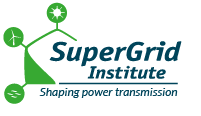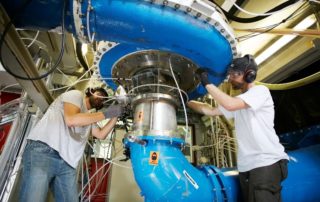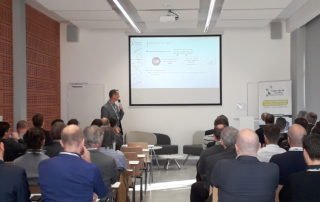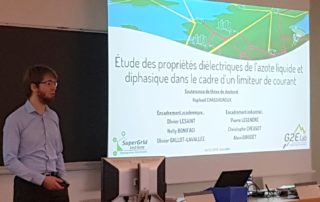Nos actualités
SuperGrid Institute is working towards the EU’s 32% renewable energy goal by contributing to XFLEX HYDRO
The XFLEX HYDRO project was launched today, the 10th of December, during the United Nations climate change conference (COP25) in Madrid, Spain. This major project, led by a consortium of 19 members, will play an important role in helping the EU reach its target of producing 32% of its energy from renewable resources by 2030, by demonstrating how innovative hydropower technologies can ensure the safety and flexibility of the power system.
SuperGrid Institute is working towards the EU’s 32% renewable energy goal by contributing to XFLEX HYDRO
The XFLEX HYDRO project was launched today, the 10th of December, during the United Nations climate change conference (COP25) in Madrid, Spain. This major project, led by a consortium of 19 members, will play an important role in helping the EU reach its target of producing 32% of its energy from renewable resources by 2030, by demonstrating how innovative hydropower technologies can ensure the safety and flexibility of the power system.
SuperGrid Institute’s “turbine type” readiness conclusions
How can we reduce the “S-Shaped” characteristics (stability) of a hydraulic turbine while maintaining its high performance? This spring, SuperGrid Institute completed several months of testing on different turbine designs for Pumped Storage Power Plants (PSPP). This promising and extensive research, which aims to improve power network services (supply security, flexibility, efficiency, etc.), has helped us better understand the physical phenomena and water flow that take place within turbines. It has also enabled us to corroborate our Computational Fluid Dynamics (CFD) simulation tools. A patent application was filed in September 2019 on this new technology.
SuperGrid Institute’s “turbine type” readiness conclusions
How can we reduce the “S-Shaped” characteristics (stability) of a hydraulic turbine while maintaining its high performance? This spring, SuperGrid Institute completed several months of testing on different turbine designs for Pumped Storage Power Plants (PSPP). This promising and extensive research, which aims to improve power network services (supply security, flexibility, efficiency, etc.), has helped us better understand the physical phenomena and water flow that take place within turbines. It has also enabled us to corroborate our Computational Fluid Dynamics (CFD) simulation tools. A patent application was filed in September 2019 on this new technology.
A DC voltage source for long term GIS testing designed by SuperGrid Institute
As part of its research, SuperGrid Institute studies the phenomena of partial discharge under DC voltage. Environmental issues emphasised in the European project PROMOTioN encourage the exploration for possible replacement of SF6 gas and remains a strong component of the study at SuperGrid Institute.
Françoise Lamnabhi-Lagarrigue has been awarded the Irène Joliot-Curie 2019 Prize in the Female Scientist of the Year category
Françoise Lamnabhi-Lagarrigue has been awarded the Irène Joliot-Curie 2019 Prize in the Female Scientist of the Year category. Congratulations to Françoise for this acclaimed recognition of her work!
Françoise Lamnabhi-Lagarrigue has been awarded the Irène Joliot-Curie 2019 Prize in the Female Scientist of the Year category
Françoise Lamnabhi-Lagarrigue has been awarded the Irène Joliot-Curie 2019 Prize in the Female Scientist of the Year category. Congratulations to Françoise for this acclaimed recognition of her work!
SuperGrid Institute’s “Technical days”: an event dedicated to our industrial shareholders
SuperGrid Institute has held its first ever ‘Technical days’ event! Dedicated to our industrial shareholders, this event was organised to facilitate exchange and to allow us to better adapt our roadmap to the industry’s tangible needs. These two exciting days of workshops, discussions and networking have bolstered our belief in the importance of our mission to shape tomorrow’s HV & MV power transmission grids.
Design and validation tests of 320kV HVDC GIL/GIS
This paper gives an overview of electrical DC phenomena in GIL/GIS, the influence of insulating properties of SF6 and filled epoxy resin, and design of new support insulator for 320kV HVDC GIL/GIS. The busbar system including the insulator was designed not only to satisfy all standard requirements such as mechanical, temperature rise, heating cycle performance but also particular requirements for HVDC applications such as superimposed impulse tests. Finally and for the first time at actual scale, type test according to CIGRE JWG D1/B3.57 was conducted in EDF R&D Les Renardières laboratory to verify the design and insulating performance of the 320kV HVDC GIL/GIS system. The satisfactory results allow to confirm the high technology readiness level of HVDC GIL/GIS.
Phd Raphael CHASSAGNOUX “Dielectric study of liquid and boiling nitrogen – Application to a superconducting fault current limiter”
The increasing number of interconnections in electrical networks and the massive integration of renewable energies nowadays comes with an increase of short circuit currents, and more constraints on high voltage circuit breaker during the current clearance. To solve this problem, a solution consists in inserting a fault current limiting device on electrical lines. Among the available technologies, the superconducting fault current limiter is ideal from the perspective of transmission system operator. However the design of this device is non-trivial, especially the electrical insulation, which is very specific to this apparatus: electrical insulation in a cryogenic environment (liquid nitrogen at - 196°C), superconducting tapes inducing electric field reinforcement, and strong transient heating generating numerous vapor bubbles.








